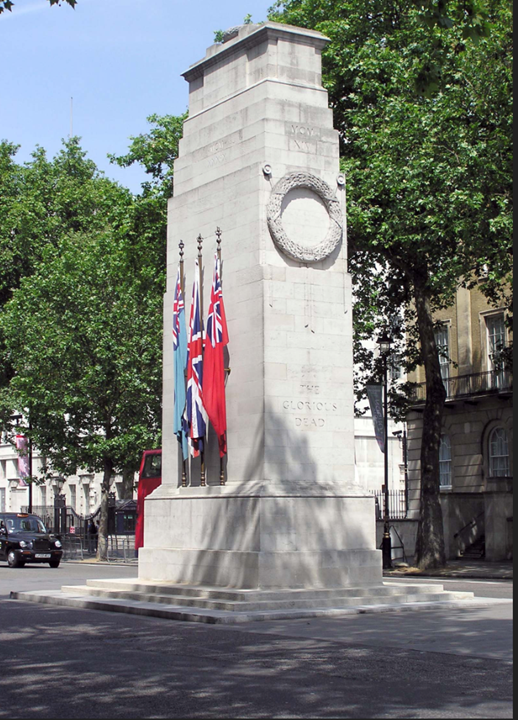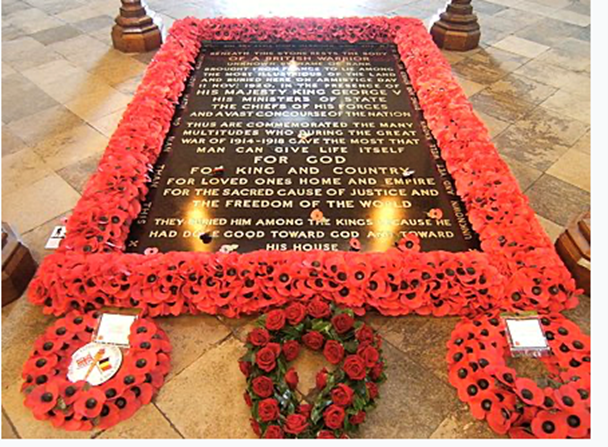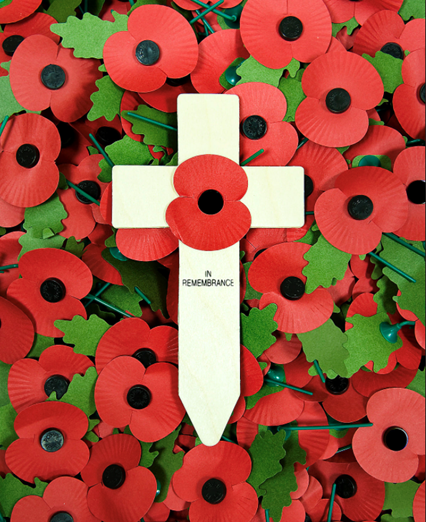
This Sunday, 10th November, the annual Remembrance Parade for our war dead takes place in Whitehall. At the eleventh hour of the eleventh day of the eleventh month in 1918, the guns fell silent on the Western Front. Every year at that time on the Sunday nearest to the 11th, the nation listens to Elgar’s Nimrod, holds a two-minute silence, hears the Last Post and witnesses wreath-laying and a march-past of veterans in salute of the war-dead at the Cenotaph.
Cenotaph means ‘empty tomb’. It is an empty tomb because many of the over one million British war-dead from the First World War have no known grave. The policy at the time was not to repatriate the dead but to bury them where they fell. To bring them home would have been a monumental task and the sight of the thousands of coffins would have had an adverse effect on public opinion and morale. After the war, those dead who were identified were re-buried in huge war cemeteries in Northern France and Belgium. Those unidentified were marked simply as a Soldier of the Great War. All except one. One body was brought back to be interred in Westminster Abbey in the Tomb of the Unknown Warrior.

Up and down the land, at the same time, remembrance ceremonies and services will take place at city cathedrals, at parish churches and at town and village war memorials. Originally it was to commemorate and pay respects to the men and boys who fell in battle during that first dreadful War to End All Wars but soon the dead of the Second World War were included after the end of that one. Then the Korean War, the Falklands War, the Gulf wars and all other lesser conflicts which the United Kingdom has been involved in over the 106 years since 1918.
Since I am a former military man there is a personal dimension to Remembrance Day for me.
I served in the RAF for 19 years, 15 of those years as a fighter pilot, but I was not called upon to go to war. The RAF had the opportunity to get me involved during the Falklands War, but the hostilities ceased before I was due to report for a Harrier refresher course and be sent to the South Atlantic. By the time of the first Gulf War in January 1991, I had been out of the Service for nearly two years. However, as a former operational Tornado pilot, I was still on the reserve list and expected that I might have some involvement even if it was only to be in a ground-based support capacity. The telephone didn’t ring and no brown OHMS envelope arrived. By the time my five years as a reserve officer was over, my chest was still as devoid of medals as the day I joined.
Fast-jet military aviation is a hazardous business. To be effective, training must be realistic; with realism comes risk, even if it is a calculated risk. In the 1970s and 1980s we lost jets, and their pilots and navigators, at a worrying rate in peacetime training. Whether it was striking the ground, mid-air collision, cannon-shell ricochets, bird-strikes, technical failures or a straight-forward pilot error, it seemed that at one point hardly a month went by without the RAF losing an aircraft and perhaps its crew as well. I had a few narrow escapes myself and joined the "Martin-Baker Club" when, following an engine malfunction, I was forced to abandon my jet at low level and leave it splattered across the floor of a Welsh valley.
I counted them up again today: Nineteen. Nineteen young men whom I had known, flown with, trained with and had fun and beers with who had lost their lives in peacetime training. One for every year of my own service. Although I couldn't make it to all the funerals, I attended more than half of them. Two were memorial services only because the bodies were never found. These were the ones I had personally known but there were many others. And, of course, there have been losses in the wars.
I think of them on this day.
We who are the children of the World War 2 generation had not been born before our fathers or mothers went into harm's way. My father was an RAF bomber pilot, flying first Handley-Page Hampden light bombers with 50 squadron RAF, then Mosquito pathfinders with 109 squadron. His role on operations was to go in ahead of the main bomber force and mark the target from low level using pyrotechnic flares. As the marking flares lasted a finite time and would drift on the wind, Pathfinder crews often had to fly in again underneath the main bomber stream to re-mark the target. Pathfinders’ target marking operations were interspersed with normal bombing missions.
All in all, he few 120 operations - 120 - over Third Reich territory, leaving a ‘calling card’ at many major German cities which I would visit later myself when I was based in West Germany during my own RAF service. That is a remarkable total at a time when the chances of a bomber crew surviving a full 'tour' of 30 'ops' were slim. He did have a couple of non-operational accidents but escaped with minor injuries. Statistically, he should not have survived 120 operations in which case I would not be here to write this.
He died young at the age of 53 when I was on the threshold of my career. I was unable to share my experiences with him or to break down his reticence about his wartime service. I know it scarred him, but he never spoke about it. They were the silent generation too.
My wife’s father was a merchant seaman, a ship's officer. He sailed on the Atlantic and Arctic convoys. In 1943 his ship was torpedoed by a U-boat and sunk. Fortunately, the ship did not go to the bottom as rapidly as others did so the crew had time to launch lifeboats and he was aboard one, the only officer with about a dozen crewmen. They were not picked up because naval policy was for the convoy to continue on course and the destroyer escorts wouldn't leave the convoy because to do so would leave a gap in the defensive screen through which more U-boats could slip.
He and his crewmen were adrift in the North Atlantic for nearly two weeks during which some died. Eventually the survivors were picked up by the Nantucket Coast Guard and taken to Hospital. My father-in-law had lost a considerable amount of weight, had deep sores due to the exposure and sustained a permanent realignment of his right shoulder bones due to many long hours at the lifeboat’s tiller in heavy seas.
He was in hospital in Nantucket for a year, his convoying days over. On repatriation he spent several weeks recuperating in hospital at home in Haverfordwest, Pembrokeshire where he met my late mother-in-law. He was very lucky to be alive.
Had he not survived, my wife, my daughter and my granddaughter would not be here.
My father and my late father-in-law were among the lucky ones. Such are the fine margins between existing and not existing.
This Sunday, as I ring the bells at our parish church for the Service of Remembrance, I will, of course, reflect on the solemnity of our national Remembrance Day for the millions of war dead and the war dead of our Parish. However, my thoughts will be on the nineteen fellow pilots and navigators whom I had known who made the ultimate sacrifice in peacetime. They will also be on those fingers of fate which, through the wartime survival of both my father and my wife’s father, had permitted our own small family’s existence.
